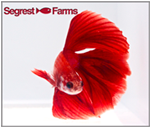Carp species such as Koi and Goldfish are susceptible to several serious pathogens including SVC and KHV. Sooner or later, anybody who keeps fish should start looking into how to integrate biosecurity measures to ensure the long term health and success of their tanks. What exactly is biosecurity? Simply put, it is a fancy term for how to minimize the risk of introducing diseases to your fish. For the large scale suppliers of ornamental fish, biosecurity is a never ending concern. Fish farms and wholesalers have lost their entire inventories, and sometimes even their businesses, as the result of pathogens quickly rampaging through their fish. Does the time and care that these companies put towards this mean that you are completely safe and never have to worry about it? Unfortunately not. "Danger Levels" of Disease The World Organization of Animal Health (abbreviated OIE from the French title) classifies pathogens into three levels based on the severity of the disease and its potential for widespread destruction. At the highest level are pathogens that have the potential to quickly spread and cause massive death and economic impact. There are nine such pathogens classified at this level that affect fish, but only three (Spring Viraemia of Carp, Red sea bream iridoviral disease, and Koi Herpesvirus Disease) are of concern to the ornamental species we keep in aquaria. While the chance of one of these viruses slipping through undetected can never be zero, the odds of of a retailer or hobbyist encountering one of these is relatively low. Below this level are pathogens that are less devastating but that should still never be present in a facility. Fortunately, these pathogens are not naturally occuring in any ornamental species and instead being almost exclusively found in game fish such as trout and salmonids. Koi have been experimentally infected with Viral Haemorrhagic Septicemia, but have so far have never shown any sign of infection from natural exposure methods. The chance of any fish infected with a second level pathogen making it to a retailer or hobbyist is extremely remote. The lowest level of pathogen is the classification that we need to be most concerned about. These are the relatively "minor" diseases (at least when compared to the classifications above) that in all reality are likely to be found in virtually all systems at all levels. Fortunately, with care, we can minimize the risk of problems arising from the presence of these pathogens. What Diseases Are We Talking About? Virtually all of the common aquarium ailments we face are in this lowest classification. Most of these are bacterial or parasitic, though a few viruses (such as Lymphocystis) or fungi can show up as well. Potential bacterial infections include Columnaris (the most common bacterial infection seen in aquaria), Aeromonas, and Streptococcus. Potential parasites include Ich (Ichthyophthirius), Tetrahymena, and Velvet Disease (Piscinoodinium). Treatment of these infections vary, and there are many resources to help you learn to treat them. Prevention is Key The best way to keep your fish healthy is to prevent them from contracting the illness in the first place, but how do we do this when these pathogens are always present? All living animals have an innate immune system that helps them fight off the organisms that can make them sick, but there is a limit to how many pathogens it can fight off at any given time. The key, then, is to maximize their immune system while minimizing the amount of pathogens they are exposed to. Doing so ultimately comes down to good husbandry practices. When fish become stressed, they respond by producing the hormone cortisol. The higher the cortisol concentration, the fewer white blood cells are produced, which are the cells that fight off infection. When there are too few white blood cells, they become overwhelmed and the fish becomes sick. There are many factors that can stress a fish, and it is our responsibility to reduce these as much as possible. Shipping, poor water quality, inadequate diet, and incompatibilities that lead to aggression are all stressors that will inhibit a fish's immune system. Likewise, poor water quality, over stocking, and introducing unhealthy fish can all increase the number of pathogens in a system, increasing the possibility of overwhelming your fish. One common theme that you should be noticing is the importance of water quality in keeping fish healthy. Keeping your water chemistry and temperature stable and at values that are comfortable to the fish you are keeping is the absolute best method of reducing stress and allowing your fish to have the strongest immune system possible. Ensure you have adequate filtration that is regularly maintained to supply clean water. Keep a careful eye on your fish and remove any fish that dies before it releases pathogens and fouls the water. Quarantine Perhaps the best method of reducing the chance of introducing new pathogens to your tank or system is through quarantining new arrivals. If used properly, quarantines can be beneficial in a number of ways. It allows time for unnoticed problems to be observed and treated before spreading to your existing fish. Quarantines allows time for your fish to acclimate to your food and water quality without worrying about other aquarium inhabitants creating further stress. It also allows their immune systems to recover from the stresses of shipping. In order for quarantines to work, there are a few considerations to keep in mind. As obvious as it may seem, your quarantine must be a dedicated tank or system that is in no way connected to your man tanks. This eliminates a path for organisms to travel from an infected fish to existing healthy ones. Your quarantine needs to be easy to disinfect in between stockings to prevent pathogens introduced with one batch of fish to be passed on to later batches. Keep your quarantine's water quality very high and ideally use a UV sterilizer that can aid in killing introduced pathogens. Finally, make sure that you follow an all-in, all-out stocking regimen in your quarantine. If you rotate fish through (where new fish are put in before old fish leave) can result in pathogens on the new fish being transmitted to the older fish right before they are transferred to your main tank. Prevent Cross-Contamination Any time you have multiple tanks or systems, care needs to be taken to ensure that diseases are not passed from one to the other. The first, and probably biggest, source of contamination comes from fish nets. Whenever a fish is caught in a net, a little bit of its slime coating sticks to the net, and there are often enormous amounts of organisms living in this slime that can easily be transferred to other tanks and systems. This is quite potentially the strongest vector for the spread of disease in the retail or home environment. Any other material that is transferred from one tank to another can also carry pathogens from tank to tank. Some potential sources of contamination include moving plants or decorations between tanks, using the same cleaning sponges or (in the retail environment) catch cups without disinfecting between tanks, and hands (or pet noses) that go from one tank to another. Fortunately, there are a number of easy ways to disinfect supplies including commercially available disinfectants, chlorinated water, or even salt water. UV Sterilization While there are many medications out there to kill off bacteria, parasites, and fungi, they can all be somewhat damaging to the overall balance of your tank, causing side effects in (and potentially even killing) the animals in your tank or devastating the beneficial bacteria levels in your tank. These medications, while often the best solution when problems arise, are not ideal to use regularly to try to reduce the overall pathogen level in your tanks. This is where UV sterilization can be of value. UV sterilizers work by exposing water to UV-C rays that are lethal to virtually all living organisms, including viruses for which there are often no medicinal cures. While this won't kill of any organisms that are already established within your fish, proper UV sterilization will kill any pathogens that are freely floating in the water, preventing them from causing further infection. It can also prevent pathogens present in one tank of a multiple tank system from traveling to and infecting other tanks, provided the system is properly laid out. Unfortunately, no method is 100% effective and any pathogens that are adhered to surfaces and not freely floating in the water will not be affected. Intelligent System Design When you have a system where multiple tanks are connected to one filtration system, as are common in retail stores, there are two potential designs that can be followed. The most basic is a serial system where the water flows from the filter to the first tank and then from tank to tank until it returns to the filter. The problem with this design is that any pathogens present in a tank can directly be carried to every subsequent tank. The better design is a parallel system where the water from the filter is split into multiple paths, each leading to its own tank. Each individual tank then drains back to the filter. When a UV sterilizer is used in such a system, any pathogens that travel from the tank to the filter are killed before they can be pumped to any other tank. Conclusion The unfortunate reality is that there will never be a time where all diseases are eliminated. Fortunately, fish farms, breeders, collectors, wholesalers, and every other step in the supply chain before a fish arrives in your local store takes great care and commits significant resources to eliminate or reduce the presence of these diseases. The fact that the great majority of fish arrive to retailers with no noticeable problems is a testament to the quality of care they receive along the way. By continuing this effort and providing a hospitable environment while reducing the risk of accidental introduction of pathogens, we give ourselves the best chance of successfully keeping happy and healthy fish.

Biosecurity for the Retailer and Hobbyist
 |
 |
|||||||||||||
|
||||||||||||||
 En Espa�ol |
| |||||||||||||








